Lithuania
Lithuania is a small Baltic republic where the world’s tallest men live, basketball is the national kind of sport, and the Internet has the highest speed in the entire European continent.
Twenty-five kilometres from Vilnius, in the village called Bernotai, the geographic midpoint of Europe is situated. And this small country has many more fascinating things to attract its visitors. So do not hesitate to buy a holiday tour to Lithuania and see everything firsthand.

General Information
The most terrestrial Baltic country has only a hundred-metre long coastline, but it does not mean that Lithuania is unsuitable for beach recreation at the Baltic Sea. Local resorts have their distinct attraction: the beaches of Palanga and Neringa lure with their cleanliness, moderate temperatures, and excellent service.
Without a doubt, this place is a must-see for everyone interested in the history and architecture of northern Europe.
Historical Background
No other Baltic country impresses with such mighty history as Lithuania does. Nowadays, this name rarely appears in newspapers and news websites, but beginning from the 13th century, Grand Duchy of Lithuania used to be one of the most influential states in Europe.
It included the territories of Western Rus conquered by ambitious Lithuanian dukes. Gradually, the number of annexed lands was several times greater than the Duchy itself.
The growth of Lithuanian influence in Europe led to collaboration with Poland. In the 14th century, the Union of Krevo emerged. It was a document aimed at uniting two countries and converting the pagan Lithuanians into Christian Catholicism.
However, the following events deterred the plans from happening. The internal strife made the Grand Duke of Lithuania, Jogaila, concede power to his cousin. Those events led to the continuation of the independent policy of the Duchy. Uniting with the Polish Kingdom was postponed until 1569, when Grand Duchy of Lithuania became a part of the Kingdom of Poland. The Union of Lublin was signed and thus established the Polish-Lithuanian Commonwealth. The two countries got one elected king and the Sejm (parliament).
That country existed for 300 years. Meanwhile, the Commonwealth became impoverished, weak, and thus the prey for the mighty Russian Empire.
Lithuania remained under its influence till the beginning of World War I. In 1915, the German troops occupied the entire Lithuanian territory. At that time, a political movement aimed at ensuring the complete independence of Lithuania started to grow.
That became possible only in a couple of years. German Emperor Wilhelm II recognized the independent Lithuanian state in March 1923.
However, the country did not manage to become a full-fledged republic at once. The main reason was its forced participation in military campaigns imposed by Soviet Russia, Germany, and Poland.
Later, in July 1940, Lithuania acceded to the USSR and was occupied by Germany at the beginning of WWII.
The republic remained a part of the Soviet Union in the post-war period. But the internal movement for independence was growing in strength and influence again.
Lithuania was the first among the 15 Soviet republics to declare secession from the USSR. It occurred in spring 1990, six months before the official downfall of the Union.

The Supreme Council of Lithuania declares independence on March 11, 1990
All attempts of the Soviet government to bring the rebellious republic back were unsuccessful. At the beginning of September 1991, Lithuania gained independence for the second time.
Now, the Republic of Lithuania has joined all world’s key organisations. It is a full member of the UN, NATO, and EU (since 2004). In 2015, it entered the Eurozone.
Geography and Climate
Lithuania is the largest Baltic country by area despite the shortest coastline.
The republic borders Latvia, Poland, Belarus, and Russia.
As in the other Baltic countries, the Lithuanian climate is moderate, with mild winter and chilly summer. Winter temperatures range from +3°C to -7°C, and in summer, they are rarely higher than +23°C
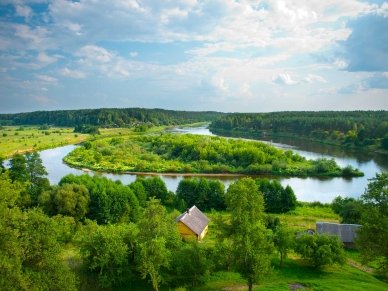
Dzukija National Park, Lithuania
Population, Language, and Currency
Lithuania is not only the largest country in the Baltic region. It is also the most populous among all Baltic states, with around three million people living there.
Nonetheless, complicated economic conditions make the Lithuanians search for employment and accommodation far beyond the homeland. Lithuania is considered one of the most demographically problematic countries in the world. Its population has decreased by one-third for the years of independence. More than a million people have moved to other European countries. At the same time, the mortality rate increases, and the birth rate tends to fall.
As in other post-Soviet Baltic countries, there are also non-citizens, a separate and very populous group who used to be the citizens of Lithuanian SSR before the collapse of the USSR. They are predominantly Russian-speaking residents of the country that have not undergone the naturalisation procedure — the exams in the Lithuanian language and history of Lithuania.
Lithuanian is the only official language. It is a unique philological phenomenon as it has retained the phonetic and morphological features of the Indoeuropean proto-language, the ancestor of modern Slavonic and European languages. Interestingly, for that reason, philologists in many universities around the world learn lietùvių kalbà (Lithuanian language).
Many Lithuanians are also fluent in English, and those born in Soviet Lithuania speak Russian very well.
Most citizens are Catholics. The church has great authority and importance in the lives of Lithuanians though Lithuania was the very last in Europe to convert to Christianity.
The capital and the largest city is Vilnius (588,500 residents), Kaunas (307,000), and Klaipėda (150,000).
Directions
The most comfortable way to get to Lithuania is to travel by air. And undoubtedly, it is the most time-saving option.
The Vilnius Airport, located 7 km from the city, is the biggest. But there are also Kaunas and Palanga Airports serving a range of airlines. Such airline companies as Ryanair, LOT, airBaltic, Scandinavian Airlines, Turkish Airlines, Wizz Air, Finnair, GetJet, Lufthansa, and others operate through Vilnius Airport.
Tourists can get to the city by buses no.1, 2, 88, or to the railway station by railcar.
It is also possible to travel to Riga from Vilnius Airport as there is a regular bus connection.

Accommodation
Lithuania is one of the most beautiful and distinctive European countries, that is why the influx of tourists does not decrease regardless of the season.
July is a perfect time for visiting Palanga, Neringa, and Klaipėda. Short and chilly summer is perfectly suitable for those who cannot stand the heat and crowded places. There is a wide variety of accommodation ranging from two-star hotels to luxury suites. Visitors may also opt for youth hostels, guesthouses, and rented apartments.
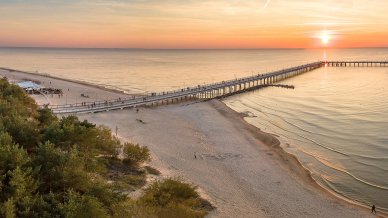
Beach in Palanga, Lithuania
Lithuania is an excellent place for a relaxed holiday and enthralling excursions during the rest of the year. The hotels of Vilnius, Kaunas, Šiauliai, and famous Lithuanian health resorts like Druskininkai, Birštonas, and the Curonian Spit welcome tourists all year round.
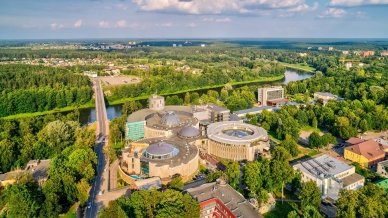
Druskininkai, Lithuania
The prices are considerably lower than in other European countries, but the hotel star rating does not usually correspond to the services. Nonetheless, the due care of staff substantially balances the limited functionality of some hotels. In any case, before booking a hotel, it is highly recommended to read the customers’ feedback:
- Amberton Green Apartments Palanga is a comfortable four-star hotel located a 10-minute walk from the beach. There are restaurants, cafes, shops, and the Palanga Amber Museum nearby. The hotel offers buffet-style food and a swimming pool. There are kitchenettes in the rooms. Breakfast and a car park are fee-based.
- Courtyard by Marriott Vilnius City Center is a four-star hotel in Vilnius, located a 5-minute walk from the historic centre of the city and 2 km from Gediminas’ Tower. The rooms are equipped with all the necessary facilities, including kitchenettes. The food is offered in a smorgasbord style.
- Amberton Hotel Klaipėda is a four-star hotel in Klaipėda that offers rooms overlooking the sea, a casino, three restaurants, a bar, an indoor swimming pool, and a SPA. Breakfast and Wi-Fi are free of charge.
- Senoji Palanga is a three-star cosy cottage-type hotel in Palanga. The country-style rooms comprise all the essential facilities, such as a bathroom, a shower, modern TV sets, free Wi-Fi, and tasty breakfast. There is also a car park within the hotel’s territory.
- Radisson Hotel Kaunas is a four-star hotel in the centre of Kaunas, not far from Laisvės Alėja. The rooms are equipped with all the necessary things. Children under the age of 11 live with their parents free of charge. The hotel also welcomes its guests to a restaurant, a bar, a casino, and a SPA.
An uneasy economic situation makes Lithuanians search for other legal ways to earn money. And letting an accommodation has taken the top position in the list.
Embarking on a tour, a package holiday, or a treatment to Lithuania, you may save a great deal of money if you decide to rent an apartment or a house. It will be considerably cheaper, but the local prices are dependent on the season, remoteness of a dwelling from the sea, and sightseeing attractions.
While the price for a budget-friendly hotel room can start from €30 or higher, a small apartment will cost around €15 - €20 per night. You may book accommodation in advance via specialised websites like Airbnb.
Places to See
Lithuania is always a full range of impressions for everyone arriving in this Baltic country. The nature here is stunning and so well-kept by every available means. The monuments of architecture, Catholic cathedrals, and monasteries are so numerous that will undoubtedly remain in visitors’ memory and the gigabytes of taken photos and videos.
Vilnius
The Lithuanian capital is a real museum of the Middle Ages era and simply a city with an unusual atmosphere.
Most guided tours of Vilnius begin with the Church of St. Anne, which, for a good reason, is considered the city’s visiting card. Constructed with 30 brick types by the Franciscans, it stuns with lacy lightness and elegance of lines.
Modern architects and builders should learn from the Middle Ages professionals — the church has encountered a lot of wars during its existence. In Soviet times, it used to be a warehouse but survived after all the calamities. It has remained one of the best samples of Gothic-style architecture.
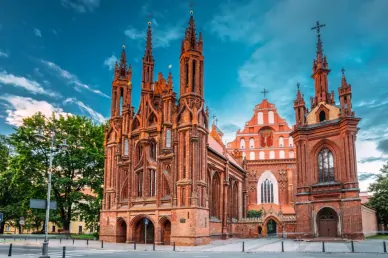
Church of St. Anne, Vilnius
There is one particular place in Vilnius that people from entire Europe aspire to visit, searching for relief and marvel. It is the chapel with the icon of the Virgin Mary called Our Lady of the Gate of Dawn located not far from the former city’s gate.
The icon is painted in a specific style and honoured by Christians of all denominations. The Lithuanians, Polish, Belarusians, and Russians pray to it with equal wholeheartedness. The chapel’s walls are covered with hearts — the gifts of the healed by the icon.
The residents of the Baltic regions are known as not very emotional. However, in reality, it is an outdated stereotype because almost nowhere in the world can people joke and have a lot of fun as in Lithuania.
The brightest example is Užupis, the Montmartre of Vilnius, which originated in the 16th century as the neighbourhood of craftspeople. Later, it became a well-liked place of local Bohemia — poor artists, strolling performers, and other wasters that needed a shelter. And cheap accommodation was prepossessing.
These days, it is one of the most prestigious parts of Vilnius and the epicentre of cultural events in the city. Here, the exhibitions of the works of modern artists, photographers, and sculptors take place. And in general, the creative atmosphere prevails.
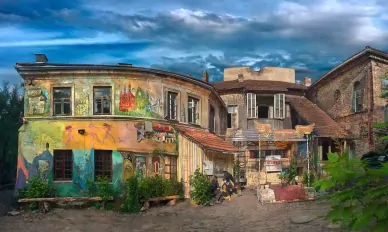
Buildings in the Užupis quarter
Užupis, or the other side of the river, is not only a Bohemian quarter. It is also a real republic with its constitution, president, and prime minister. The Day of Independence is celebrated there on April 1 in a half-joking and half-serious manner. The Constitution provisions are humorous sayings revealing the homespun philosophy of life.
For example, it says that everyone has the right to idle. And that is quite a fair point.
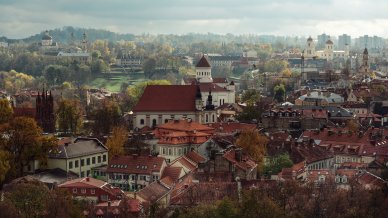
Užupis, Vilnius
To see the second brightest attraction of Lithuania, you will need to go to Zarasai district municipality on the border with Latvia. In village Stelmužė, there is the 2,000-year-old Stelmužė Oak, a witness of all the events happening in the Lithuanian land since the birth of Christ. The tree observed even the pagans performing the rituals of worshipping the highest god Perun.
A giant tree is as high as an eight-storey house, and not less than seven men can embrace it. However, despite the attempts of renovators, the legendary oak decays — its trunk is full of lichen and fungi.
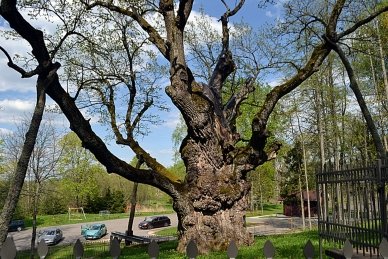
2,000-year-old Stelmužė Oak
Once in Šiauliai, go to the Hill of Crosses, the site of mass pilgrimage of Lithuanians and tourists from entire Europe.
The Hill is located 12 km from Šiauliai and is covered with crosses of various sizes — from very small, worn next to the skin, to huge ones (up to several metres high). It is considered that every person willing to change their life for the best should leave their cross there.
The Hill has gained much popularity since 1993 after Pope John Paul II visited the place and put one cross by himself.
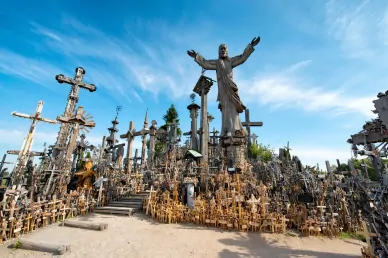
Hill of Crosses, Šiauliai, Lithuania
Food
Almost everybody knows the Lithuanian borscht called šaltibarščiai that can save from thirst in the starching heat. And nobody will be able to refuse delicious cepelinai (didžkukuliai) or potato dumplings stuffed with meat and served with fried lard and sour cream.
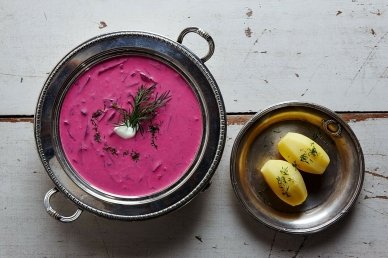
Lithuanian šaltibarščiai
So it is Lithuanian cuisine, usually made of ordinary products and simple manipulations and then turned into a real culinary masterpiece.
The Lithuanians have always had expert knowledge in making tasty food. Well-developed agriculture and a close connection with other European countries have contributed to the abundance of healthy and delicious dishes in the local cuisine.
So which one is better to try first? You may start with a thick pork soup and continue with potato sausages called vederai. Then switch to žemaičių blynai — potato pancakes filled with meat and thick sour cream. After that, try to leave the table with your stomach full. Problems with that? That is Lithuania, you know.
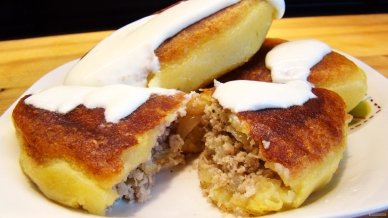
Lithuanian žemaičių blynai
The other scrumptious dish is small pastries called kibinai. Also, do not hesitate to try kastinys, the national snack cooked of mixing sour cream, butter, thyme, garlic, and green stuff. The end product is good-tasting, served with hot potatoes, and resembles a pâté.

Lithuanian kibinai
Bread is a special pride of the Lithuanians. Everyone eats it here, even those on a diet. The reason is that it is almost impossible to refuse a slice of sweet-smelling, crispy piece of Vilnius bread, Bočių, or Palanga.
If you want to try some spirits, take a glass of cold beer. Lithuanian brewers are well-known for their talent in making heady and flavourous beverages. Švyturys Baltijos Extra has gained much popularity and has even been awarded Grand Prix at the world competition in the USA.
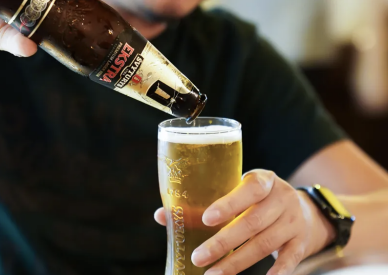
Lithuanian beer Švyturys Baltijos Extra
So if you want to spend a holiday in a country that is never too hot or too cold, delight in the beauty of nature, undergo some treatment and eat delicious food, set forth on a trip to Lithuania, one of the most beautiful places in Europe.
FAQ
What is the full size of Lithuania?
Lithuania covers an area of approximately 65,300 square kilometers.
What is the capital of Lithuania?
The capital of Lithuania is Vilnius.
What is Lithuania's population?
The population of Lithuania is around 2.8 million people.
Which language do Lithuanians speak?
The official language spoken in Lithuania is Lithuanian.
What is Lithuania's main religion?
The main religion in Lithuania is Roman Catholicism.
Is Lithuania a democratic country?
Yes, Lithuania is a democratic country with a parliamentary system of government.
What is Lithuania's main source of income?
Lithuania's economy is diverse; major sources of income include manufacturing, information technology, services, and agriculture.
Is Lithuania in the EU?
Yes, Lithuania is a member of the European Union.
Does Lithuania use the euro?
Yes, Lithuania uses the Euro (EUR) as its currency.
What is Lithuania best known for?
Lithuania is known for its rich history, beautiful landscapes, baroque architecture, particularly in Vilnius, and a strong cultural heritage in arts, music, and literature.
Is Lithuania a good place to live?
Lithuania offers a good quality of life with its natural beauty, cultural heritage, and modern amenities, although like any country, this can vary based on individual preferences and lifestyle.
Is Lithuania expensive for tourists?
Lithuania is generally considered affordable for tourists compared to many Western European countries, though prices in urban areas like Vilnius can be higher than in rural areas.
What are the documents required for visiting Lithuania?
Visitors to Lithuania typically need a valid passport. EU citizens can enter with an ID card. Visitors from many countries require a Schengen visa for longer stays. It's advisable to check current requirements based on your nationality and any specific health or travel advisories.
